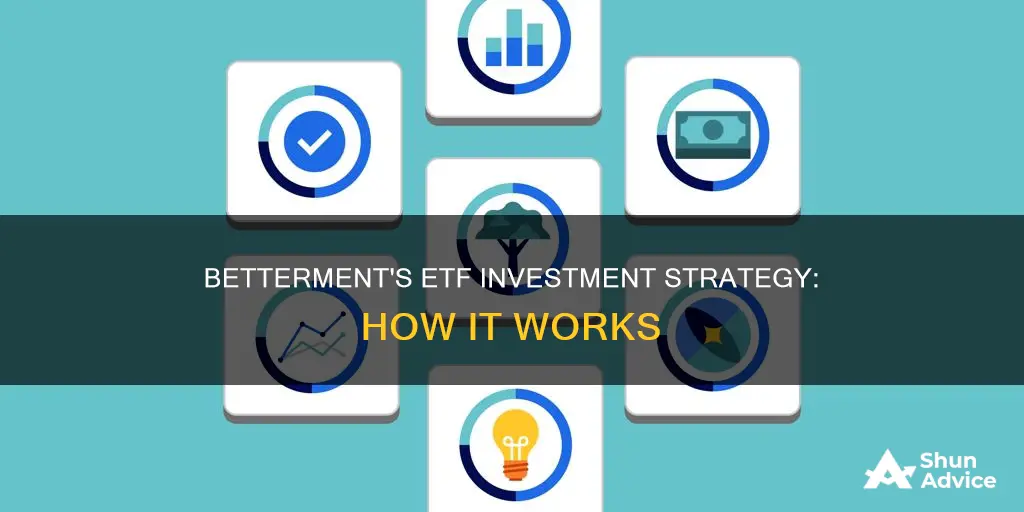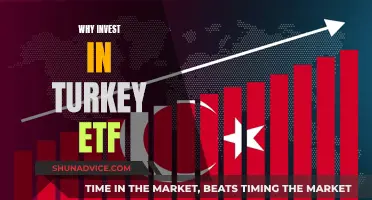
Betterment is a robo-advisor that uses computer algorithms to generate personalized advice and manage your investment portfolio. It offers a range of portfolios, including those focused on socially responsible investing and innovative technology. These portfolios are made up of exchange-traded funds (ETFs) that track a broad market stock or bond index or a basket of assets. ETFs are favoured by Betterment due to their low costs, high liquidity, and tax efficiency. While there is no minimum balance requirement, there is a $10 minimum deposit to start investing.
What You'll Learn

Betterment's Core Portfolio
The Core Portfolio is designed for investors seeking global diversification and optimised exposure to stocks and bonds. It is underpinned by Betterment's capital market assumptions (CMAs), which represent the company's long-term expectations for the return and risk of various asset classes. These CMAs inform how Betterment allocates investments across different asset classes and power the platform's advice tools.
In January 2024, Betterment updated its Core portfolio strategy to improve long-term risk-adjusted returns. The changes included dialling down exposure to emerging markets stocks while increasing exposure to U.S. stocks, reducing the emphasis on U.S. value stocks, and increasing allocations to inflation-protected U.S. bonds. Betterment also updated its Core portfolio construction methodology to become more "benchmark aware," calibrating exposures based on a custom benchmark composed of the MSCI All Country World Index, the Bloomberg Global Aggregate Bond Index, and the ICE US Treasury 1-3 Year Index.
The Core Portfolio has relatively low expense ratios, ranging from 0.05% to 0.11%. Betterment uses ETFs in the Core Portfolio because of their low management fees and tax efficiency. The portfolio is also optimised for tax efficiency, with automated and optimised tax strategies designed to minimise the tax impact on returns.
ETFs: Real Investments or Just a Fad?
You may want to see also

Betterment's BlackRock Target Income Portfolio
The portfolio is actively managed by one of the largest asset managers in the world, and all dividends are automatically reinvested. There are four or five different portfolio strategies to choose from, each consisting of 100% bonds and targeting increasingly higher yields. The specific portfolio chosen should be based on the investor's risk tolerance. While the volatility of bonds is substantially lower than that of stocks, investing in bonds is not without risk.
The BlackRock Target Income Portfolio is not suitable for all investors, particularly those outside of a tax-advantaged retirement account. Additionally, in an inflationary and rising interest rate environment, an all-bond portfolio is likely to be very painful as bond prices go down when interest rates rise.
ETFs and Unit Investment Trusts: What's the Difference?
You may want to see also

Betterment's Goldman Sachs Smart Beta Portfolio
The Smart Beta portfolio is more heavily exposed to risk than the default Betterment portfolio. It incorporates certain stock exchange-traded funds (ETFs) that do not weight their holdings based solely on market capitalisation. Instead, these ETFs make rules-based adjustments to the market weights of their holdings based on four factors that academic research has identified as persistent drivers of investment returns in stocks: good value, high quality, low volatility, and strong momentum.
The Smart Beta portfolio also incorporates certain fixed-income ETFs that do not weight their holdings based on market capitalisation. These ETFs use liquidity, technical, and fundamental screening criteria to screen out select government, mortgage, and corporate bonds and issuers to minimise exposure to factors associated with volatility and underperformance.
The selection and relative weights of ETFs in the Smart Beta portfolio for a given allocation of stocks and bonds are determined by Goldman Sachs. The portfolio is designed by Goldman Sachs Asset Management and is generally comprised of ETFs managed by Goldman Sachs, although it may also include ETFs managed by other fund managers.
The Smart Beta portfolio has 101 different allocation options, from 0% bonds to 100% stocks. It offers automated and optimised tax strategies designed to minimise the tax impact on returns and is adjusted automatically as the market moves.
A Beginner's Guide to Smart ETF Investing
You may want to see also

Betterment's Flexible Portfolios
The Flexible Portfolio option starts with the Core portfolio's distribution of asset classes, including Commodities, High-Yield Bonds, and REITs. Investors can then adjust the weights of these asset classes according to their preferences.
Betterment provides a risk and diversification assessment of the changes made by investors, allowing them to understand the risks of their adjustments. While the Flexible Portfolio offers more control, it also requires careful consideration, experience, and effort in managing the portfolio.
One drawback of the Flexible Portfolio is the disabling of the Auto-Adjust feature, which automatically reduces the overall risk level of the portfolio as the end date of the investment goal approaches. Without this feature, investors are responsible for manually maintaining the appropriate allocation of stocks and bonds and their corresponding risk levels.
Additionally, altering or removing asset classes in the Flexible Portfolio may impact the effectiveness of tax-saving strategies, such as Tax Loss Harvesting+ and Tax Coordination.
ETFs: A Collective Investment Scheme? Understanding the Basics
You may want to see also

Betterment's Socially Responsible Investing Portfolio
Betterment's Socially Responsible Investing (SRI) portfolios are designed to support companies that share your values, such as funding green projects and promoting gender diversity, while investing in cost-effective ETFs. The SRI portfolios are constructed using a set of industry criteria known as "ESG," which stands for Environmental, Social, and Governance.
Betterment's Approach to SRI
Betterment's approach to SRI has three fundamental dimensions:
- Reducing exposure to investments involved in unsustainable activities and environmental, social, or governmental controversies.
- Increasing exposure to investments that address solutions for core environmental and social challenges.
- Allocating to investments that use shareholder engagement tools, such as proxy voting, to incentivize socially responsible corporate behaviour.
Betterment's SRI Portfolios
Betterment currently offers three SRI portfolios:
- Broad Impact Portfolio: This portfolio focuses on ESG investing and seeks to balance each of the three ESG dimensions (Environmental, Social, and Governance). It includes an allocation to an engagement-based SRI ETF.
- Climate Impact Portfolio: This portfolio is designed for investors who want to focus on the environmental pillar of ESG. It invests in companies with lower carbon emissions, funds green projects, and divests from fossil fuel reserves.
- Social Impact Portfolio: This portfolio is designed for investors who want to focus on the social pillar of ESG. It includes ETFs that promote gender and racial diversity, as well as support minority empowerment and social equity.
Performance Considerations
It's important to note that SRI portfolios may have lower dividend yields compared to non-SRI portfolios due to the exclusion of companies with high dividend yields, such as oil and gas companies. However, a white paper studying the relationship between ESG investing and performance found positive correlations between ESG performance and operational efficiencies, stock performance, and lower costs.
Fees and Requirements
Betterment's SRI portfolios are available with the basic Betterment service, which charges a 0.25% annual fee or $4 per month, depending on your balance. There is no minimum balance requirement to invest in the SRI portfolios, but a $10 minimum deposit is needed to start investing.
Lithium ETF: A Smart Investment Strategy for Beginners
You may want to see also
Frequently asked questions
Betterment uses ETFs in both stock and bond portfolios because of the low management fees and tax efficiency they offer. ETFs are securities that track an index, commodity, or basket of assets like a stock on an exchange. They have clear goals and mandates, intraday availability, low fee structures, tax efficiency, and investment flexibility.
ETFs have certain structural advantages when compared to mutual funds. They have clear goals and mandates, intraday availability, low fee structures, tax efficiency, and investment flexibility.
Betterment's ETF selection process involves assessing the total annual cost of ownership and mitigating market impact. They consider factors such as volume, bid-ask spread, expense ratios, and tracking difference to determine the total annual cost of ownership. To mitigate market impact, they consider the relative size of their platform in terms of assets under management and daily traded volume.
As with any investment, ETFs are subject to market risk, including the possible loss of principal. The value of an ETF may trade for less than its net asset value, and there is always a risk that it will not meet its stated objective on any given trading day.







